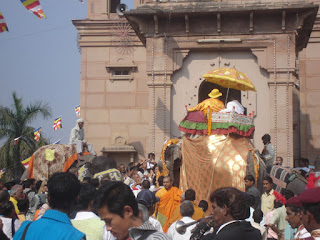 once a year, the mula-gandha kuti temple in sarnath that houses relics of the buddha allows those relics to leave the security of its inner sanctum and circle the village. as is apparently most befitting to the physical traces of an enlightened being, the relics go forth on the back of an elephant, escorted by other elephants, marching bands, pilgrims from all corners of asia, nuns and monks with horns, with cameras, with incense and with palms together, along with the occasional government official. this year for the first time ever, they were also escorted by a much delighted mexican pilgrim named flora!
once a year, the mula-gandha kuti temple in sarnath that houses relics of the buddha allows those relics to leave the security of its inner sanctum and circle the village. as is apparently most befitting to the physical traces of an enlightened being, the relics go forth on the back of an elephant, escorted by other elephants, marching bands, pilgrims from all corners of asia, nuns and monks with horns, with cameras, with incense and with palms together, along with the occasional government official. this year for the first time ever, they were also escorted by a much delighted mexican pilgrim named flora!
the relics kept here are said to have been unearthed at ruins in andhra pradesh at nagarjuna konda and at taxila in what is now pakistan, during the time of the british colonial government. the mahabodhi society administers the mulagandhi kuti temple, and both were foundered by the famous sri lankan anagarika dharmapala who did so much for the reservation of buddhist sites in india. the mahabodhi society somehow managed to secure for itself the great privilege of providing them with a more suitable home, and has shared that privilege with the entire village regularly since then.

 in what is easily the most impressive event of the year for this dusty – if sacred – little town in northern india, the relic parade took place today. locals here kept saying that it was buddha purnima, or the buddha's birthday, a day that is otherwise reckoned to take place in april, may or june based on the lunar calendar. but in fact the relic procession is regularly scheduled for karthika purnima, the full moon day in this eleventh month of the year, when the weather in november is much more manageable - it was 75 degrees today, for example.
in what is easily the most impressive event of the year for this dusty – if sacred – little town in northern india, the relic parade took place today. locals here kept saying that it was buddha purnima, or the buddha's birthday, a day that is otherwise reckoned to take place in april, may or june based on the lunar calendar. but in fact the relic procession is regularly scheduled for karthika purnima, the full moon day in this eleventh month of the year, when the weather in november is much more manageable - it was 75 degrees today, for example. 
 the largest elephant has the honor of carrying both the relics and the two VIPs who escort them, and is followed by several of its smaller brethren. the relics themselves are of course tiny and remain throughout the event in a gold container shaped like a stupa. (note if you can as well the symbol of a stupa emblazoned on the shimmery cloth draped around the lead elephant.)
the largest elephant has the honor of carrying both the relics and the two VIPs who escort them, and is followed by several of its smaller brethren. the relics themselves are of course tiny and remain throughout the event in a gold container shaped like a stupa. (note if you can as well the symbol of a stupa emblazoned on the shimmery cloth draped around the lead elephant.)no doubt about, buddha's relics and elephants together really make a parade!












